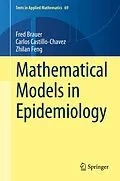The book is a comprehensive, self-contained introduction to the mathematical modeling and analysis of disease transmission models. It includes (i) an introduction to the main concepts of compartmental models including models with heterogeneous mixing of individuals and models for vector-transmitted diseases, (ii) a detailed analysis of models for important specific diseases, including tuberculosis, HIV/AIDS, influenza, Ebola virus disease, malaria, dengue fever and the Zika virus, (iii) an introduction to more advanced mathematical topics, including age structure, spatial structure, and mobility, and (iv) some challenges and opportunities for the future.
There are exercises of varying degrees of difficulty, and projects leading to new research directions. For the benefit of public health professionals whose contact with mathematics may not be recent, there is an appendix covering the necessary mathematical background. There are indications which sections require a strong mathematicalbackground so that the book can be useful for both mathematical modelers and public health professionals.
Autorentext
Fred Brauer is a Professor Emeritus at the University of Wisconsin - Madison and an Honorary professor at the University of British Columbia. His research interests are in dynamical systems and mathematical models in epidemiology. He has been active in the China - Canada Joint Program on Infectious Diseases and in the organization of several summer programs organized by MITACS ( Mathematics for Information Technology and Complex Systems) to present mathematical epidemiology to a mixed audience of mathematicians and public health professionals and encourage contacts between these groups.
Zhilan Feng is a Professor of Mathematics at Purdue University. She is an editor for Journal of Theoretical Biology, Mathematical Biosciences, Mathematical Biosciences and Engineering, Journal of Biological Dynamics, and SIAM Journal on Applied Mathematics. She is a program director for the NSF Mathematical Biology Program 2019-2020.
Inhalt
Introduction; A prelude to mathematical epidemiology.- Simple compartmental models for disease transmission.- Endemic disease models.- Epidemic models.- Models with heterogeneous mixing.- Models for diseases transmitted by vectors.- models for tuberculosis.- Models for HIV?AIDS.- Models for influenza.- Models for Ebola.- Models for malaria.- Dengue fever and the Zika virus.- Disease transmission models withagedpendence.- Spatial structure in disease transmission models.- Epidemiological models incorporating mobility, behavior, and time scales.- Challenges, opportunities, and theoretical epidemiology.
